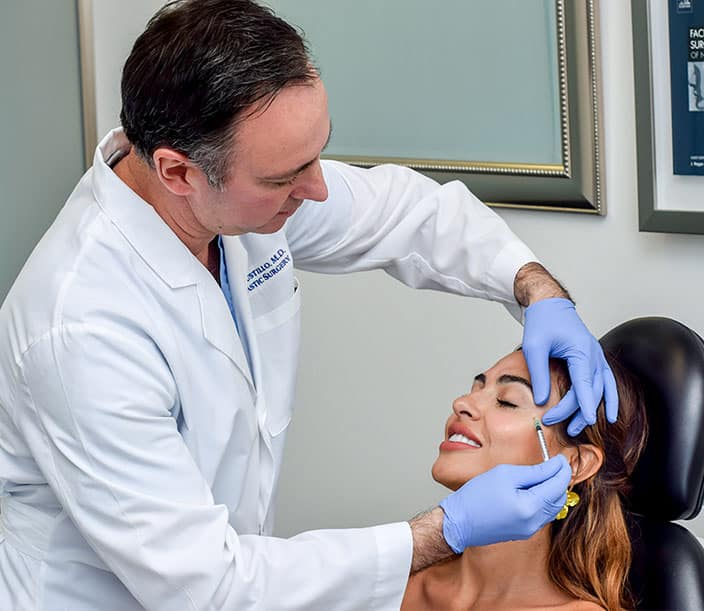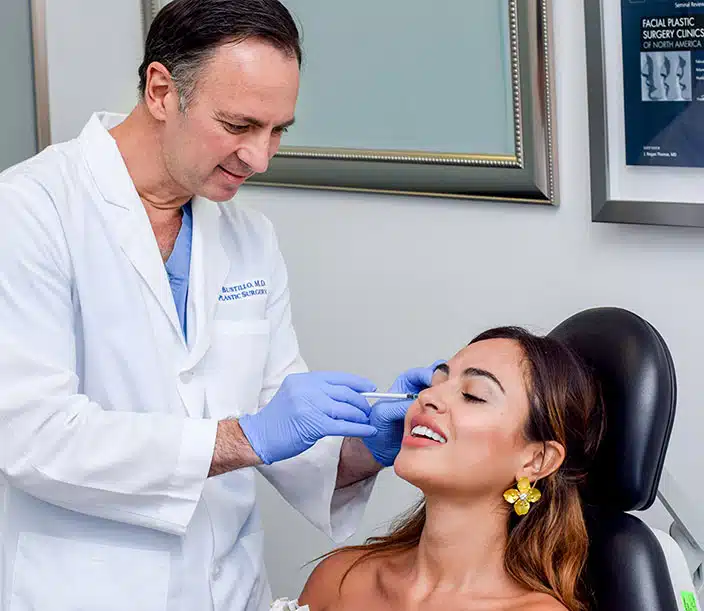Benefits of Botox to Revitalize Your Look
Botox is not just a cosmetic enhancement; it’s a gateway to renewed confidence and youthful vitality. By targeting facial muscles with precision, Botox offers a non-invasive solution to various aging concerns, redefining beauty norms. Its multifaceted benefits extend from aesthetic improvements to functional remedies, making it a popular choice for those seeking a subtle yet impactful rejuvenation.

Botox and Dysport: Understanding the Differences
There’s a reason why botulinum toxin injections — Botox® and Dysport® — are the most popular minimally invasive aesthetic treatment in the U.S.: they work like a kind of magic eraser for your face, effectively smoothing wrinkles and fine lines while instantly returning a fresh, youthful appearance without the expense or recovery associated with cosmetic surgery.

What is Botox®?
Botox® is one of two FDA-approved brand names for botulinum toxin, a purified protein substance that, when injected into strategic locations, temporarily paralyzes the area to keep the muscles from moving and causing wrinkles. And yes, the word “toxin” sounds a little terrifying, but the botulinum toxin has actually been safely used for medical purposes for over 30 years.
Initially, it was used in ophthalmology to treat blepharospasm (tremor of the eyelids), in neurology for the treatment of neuromuscular diseases, and in otolaryngology to treat facial nerve disorders. In fact, it was during its use for facial nerve conditions that physicians first realized that the toxin improved the appearance of certain facial wrinkles.
Since then, clinical trials have shown that Botox® and Dysport® injections are very safe for both cosmetic and non-cosmetic purposes.

Patient Testimonials: Real Stories, Real Results
What is Dysport®?
Like Botox®, Dysport® is a brand name for botulinum toxin injections. And just like Botox®, Dysport can be used to treat forehead wrinkles, reduce the appearance of crow’s feet, erase frown lines in between the eyebrows, and more. Dysport® is manufactured by Swiss pharmaceutical company Galderma, the makers of Sculptra and Restylane fillers. Botox® is produced by Allergan, a company that also manufactures the filler Juvederm.

Questions about your procedure?
Schedule a consultation with Dr. Andres Bustillo.
How Botox Works: The Science Behind It
To understand how Botox works, we first need to talk about wrinkles and how they form. There are two types of facial wrinkles: dynamic and static. Static wrinkles are caused by a combination of gravity and loss of skin elasticity and are typically located in the lower third of the face.
Dynamic wrinkles are caused by the normal activity of the facial muscles. Typically, these wrinkles are located in the upper third of the face and include the horizontal forehead wrinkles, the “11” wrinkles in between the eyebrows (known as glabellar wrinkles), and those around the eyes (known as crow’s feet).
Botox® and Dysport® are best suited for dynamic wrinkles. For example, when applied to the lines between the eyebrows, it can soften the stubborn “11” lines that make you look as though you were perpetually frowning. Botox can also provide a subtle brow lift for certain patients. And the injections can smooth out horizontal wrinkles and take years off your face when applied to the forehead.

Are You a Candidate for Botox or Dysport?
Botox® and Dysport® are considered a minimally invasive procedure for facial rejuvenation and there are no contraindications when used for reducing the appearance of wrinkles and fine lines.
Good candidates include women and men who are physically healthy, have realistic expectations regarding the results of the procedure and want to improve the appearance of forehead creases, glabellar lines, or crow’s feet. Botox® may not be appropriate for individuals with certain neuromuscular disorders like ALS, myasthenia gravis, or Lambert-Eaton syndrome. Make sure to ask your provider about how to prepare for your Botox procedure.
Areas Treated with Botox or Dysport
While crow’s feet and forehead wrinkles are common injection sites, Botox can actually be applied to more than a dozen areas to smooth, refresh, and rejuvenate.
Botox for Upper Face Treatments
- Frown or “11” lines
- Top of the nose / bunny lines
- Eyebrows
- Under the eyes
Botox for Lower Face Treatments
- Nasolabial folds
- Marionette lines
- Smoker’s lines
- Gummy smile
- Dimpled chin
- Jowls
- Neck bands
Botox for Body Contouring
- Underarms, for hyperhidrosis or excessive sweating
- Hands and feet
- Scalp
Botox Procedure and Recovery Process
Typically, Botox® or Dysport® injections are administered using small, ultra-thin needles. This allows for a relatively fast and painless injection. After the injection, the skin area is cooled with a small ice packet to help reduce local swelling. The swollen area typically returns to normal within two hours.
The procedure is performed in the office. After you are comfortably seated and have discussed your desired injection sites with Dr. Bustillo, one of our licensed assistants will perform acupressure to decrease sensation on the face. Then, Dr. Bustillo will gently inject the solution into specific muscles.
The procedure only takes a few minutes. After that, you can return to your normal activities right away, though you’re advised to avoid rubbing the treated area, get facials or chemical peels, and perform strenuous physical activity immediately following your treatment.
Dr. Bustillo will ask you to come back a week or two after the procedure so he can take a look at your results and apply touch ups as necessary, which are always included in the cost of the procedure.
Our Approach to Botox® and Dysport®
Dr. Bustillo believes that a natural appearance should be maintained when treating facial wrinkles. There’s a fine line between applying the right amount of Botox and “freezing” someone’s expression. So you’ll never see high arched “peaked” brows coming from our office. That’s just not how we do it.

Cost of Botox® with Dr. Bustillo
The cost of Botox injections varies depending on the number of areas being treated. Typically, the cost is $400 for one area, $850 for two to three areas, and $950 for four areas. These prices include pre-procedure consultations and the Botox treatment itself. Discussing all potential costs during your consultation is essential to ensure you have a clear understanding of the financial commitment involved. Financing options may be available for those who qualify.
Why Choose Plastic Surgeon Dr. Bustillo for Botox?
Dr. Bustillo is known as a facial aesthetics authority in Miami. He is a double board-certified plastic surgeon with over 20 years in practice and understands how to bring out the best in his patients. He is known for offering natural-looking results from both surgical and non-invasive procedures, prompting his patients to come back again and again.
- Castle Connolly Top Doctor for more than 10 years
- American Board of Facial Plastic and Reconstructive Surgery
- American Board of Otolaryngology-Head and Neck Surgery
- Facial Plastic & Reconstructive Surgery Fellowship at The New York University
- Otolaryngology – Head & Neck Surgery Residency at The University of Miami, Jackson Memorial Hospital
- General Surgery Internship at The University of Miami, Jackson Memorial Hospital


